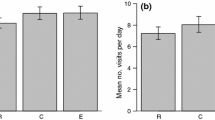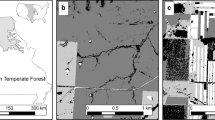Summary
Lapland longspur chicks continued to be fed by their parents for 2 weeks after nest departure. Shortly after they left the nest, broods were divided evenly into two units each tended by a single parent. Female-tended brood units dispersed away from the nest at a faster average distance per day than those tended by males. The distance between offspring within a brood unit also increased as chicks got older. For the first 8–10 d after nest departure, parents were multiple central place foragers, making 1–8 foraging trips away from each dispersed chick (i.e. the central place) before moving on to feed another chick in a similar fashion. During the final 5–7 d before independence, chicks were quite mobile and followed parents on their foraging bouts. A simulation model shows that brood dispersal reduced total parental travel time per chick, primarily because each chick moved closer to a foraging site. By comparing models for a variety of brood division and foraging itinerary scenarios, we also show that multiple central place foraging by parents visiting different, separated brood units is less energetically expensive than other reasonable alternatives.Although brood dispersal is usually considered to be an adaptation for avoiding predation, it can also help parents reduce the energetic costs of parental care.
Similar content being viewed by others
References
Chapman CA, Chapman LJ, McLaughlin RL (1989) Multiple central place foraging by spider monkeys: travel consequences of using many sleeping sites. Oecologia (in press)
Custer TW (1974) Population ecology and bioenergetics of the Lapland longspur (Calcarius lapponicus) near Barrow, Alaska. PhD thesis, University California, Berkeley
Custer TW, Pitelka FA (1977) Demographic features of a Lapland longspur population near Barrow, Alaska. Auk 94:505–525
Harrison DJ, Gilbert JR (1985) Denning ecology and movements of coyotes in Maine during pup rearing. J Mammal 66:712–719
Hurlbert SH (1984) Pseudoreplication and the design of ecological field experiments. Ecol Monogr 54:187–211
Hussell DJT (1972) Factors affecting clutch size in arctic passerines. Ecol Monogr 42:317–364
Knapton RW (1978) Breeding ecology of the clay-colored sparrow. Living Bird 17:137–158
Lack D (1954) The natural regulation of animal numbers. Oxford Univ Press, Oxford
Machlis L, Dodd PWD, Fentress JC (1985) The pooling fallacy: problems arising when individuals contribute more than one observation to the data set. Z Tierpsychol 68:201–214
Maher WJ (1964) Growth rate and development of endothermy in the snow bunting (Plectrophenax nivalis) and the Lapland longspur (Calcarius lapponicus) at Barrow, Alaska. Ecology 45:520–528
Maschwitz U, Heinz H (1985) The migrating herdsman Dolichoderus (Diabolus) cuspidatus: an ant with a novel mode of life. Behav Ecol Sociobiol 17:171–184
mcLaughlin RL, Montgomerie RD (1985a) Brood division by Lapland longspurs. Auk 102:687–695
McLaughlin RL, Montgomerie RD (1985b) Flight speeds of central place foragers: female Lapland longspurs feeding nestlings. Anim Behav 33:810–816
McLaughlin RL, Montgomerie RD (1989a) Flight speeds of parent brids feeding nestlings: which currency is maximized? Can J Zool
McLaughlin RL, Montgomerie RD (1989b) Does nest departure improve the survival of Lapland longspur chicks? Auk (in press)
Mills GS, Silliman JR, Groschupf KD, Speich SM (1980) Life history of the five-striped sparrow. Living Bird 18:95–110
Montgomerie RD, Cartar RV, McLaughlin RL, Lyon BE (1983) Birds of Sarcpa Lake, Melville Peninsula, Northwest Territories: breeding phenologies, densities and biogeography. Arctic 36:65–75
Moreno J (1984) Parental care of fledged young, division of labor, and the development of foraging techniques in the northern wheatear (Oenanthe oenanthe L.) Auk 101:741–752
Morrison DW, Caccamise DF (1985) Ephemeral roosts and stable patches? A radiotelemetry study of communally roosting starlings. Auk 102:793–804
Nolan V, Jr (1978) Ecology and behavior of the prairie warbler, Dendroica discolor. Ornithol Monogr 26
Orians GH, Pearson NE (1979) On the theory of central place foraging. In: Horn DJ, Stains BR, Mitchell RD(eds) Analysis of ecological systems. Ohio State Univ Press, Columbus, pp 155–177
Pinkowski BC (1978) Feeding of nestling and fledgling eastern bluebirds. Wilson Bull 90:84–98
SAS Institute (1982) SAS User's Guide: Statistics, 1982 ed. SAS Inst Inc, Cary, North Carolina
Skutch AF (1976) Parent birds and their young. Univ Texas Press, Austin
Smith JNM (1978) Division of labour by song sparrows feeding fledged young. Can J Zool 56:187–191
Sokal RR, Rohlf FJ (1981) Biometry. W.H. Freeman & Co, San Francisco
Tinbergen N (1939) The behavior of the snow bunting in spring. Trans Linn Soc New York 5:1–95
Trivers RL (1972) Parental investment and sexual selection. In: Campbell B(ed) Sexual selection and the descent of man. Aldine, Chicago, pp 139–179
Wilcove DS (1985) Nest predation in forest tracts and the decline of forest songbirds. Ecology 66:1211–1214
Williamson FSL, Emison WB (1971) Variation in the timing of breeding and molt of the Lapland longspur (Calcarius lapponicus) in Alaska, with relation to differences in latitude. Bio Science 21:701–707
Willis EO (1972) The behavior of spotted antbirds. Ornithol Monogr 10:1–162
Author information
Authors and Affiliations
Rights and permissions
About this article
Cite this article
McLaughlin, R.L., Montgomerie, R.D. Brood dispersal and multiple central place foraging by Lapland longspur parents. Behav Ecol Sociobiol 25, 207–215 (1989). https://doi.org/10.1007/BF00302920
Received:
Accepted:
Issue Date:
DOI: https://doi.org/10.1007/BF00302920




